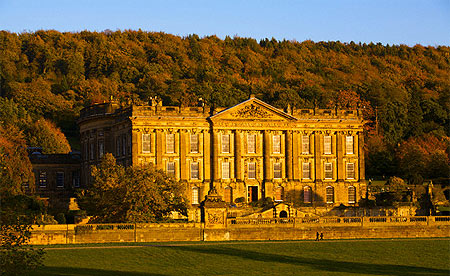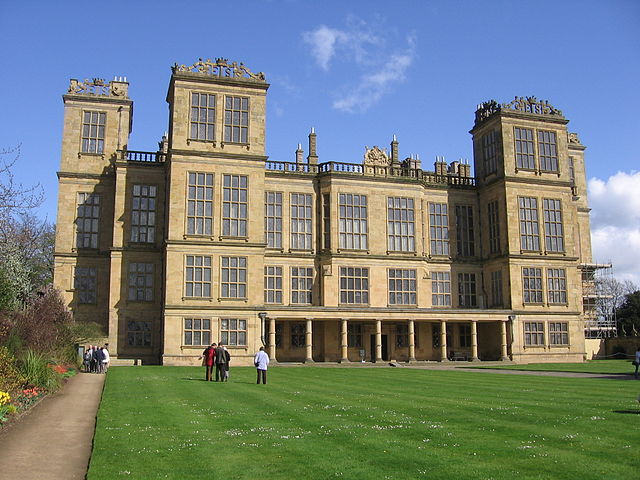|
|
Derbyshire - County of Industry and Innovation
|

The Derbyshire County Flag
|
The county of Derbyshire, located right in the centre of the United Kingdom, is home to some of the most magnificent scenery in the whole of England. But there is a lot more to Derbyshire than just the hills, valleys and moors of the Peak District as, back in the 18th and 19th Centuries, it was right at the heart of innovation in both industry and transport.
It was in Derbyshire in the late 18th Century that innovators such as Sir Richard Arkwright and Jedediah Strutt built the world's first successful cotton mills at Cromford and Belper. These early mills pioneered many of the principles of modern factory working and started what became known as the Industrial Revolution. It can even be argued that the early mills in the Derwent Valley contained early forms of the production lines popularised many years later by Henry Ford and others. These momentous events led eventually to the modern industrialised world we live in today, and Derbyshire's role in them was finally recognised in 2001 with the creation of the Derwent Valley Mills World Heritage Site.
|
|
And Derbyshire also features in the early history of modern transport as it was home to some of the earliest railways in the world, such as the Little Eaton Gangway and the famous Cromford and High Peak Railway. While some of these early lines are still in use today as part of the modern railway network, others have long since vanished. Some of these lost lines have almost completely disappeared from the landscape, while others have found new life as walking and cycling trails such as the Monsal Trail. The county town of Derby, situated right at the heart of the United Kingdom, became an important railway junction and home to both the Midland Railway and a large locomotive and rolling stock construction industry. While still a busy station for trains both to London and on the important NE-SW cross-country route, much of the earlier railway infrastructure has now disappeared, although it is still home to the UK's only surviving railway rolling stock manufacturer, Bombardier.
|
|
In 1951, Derbyshire became home to the Peak District National Park, the first national park in Britain. This occupies much of the north-western corner of the county, and also spills over into the neighbouring counties of Staffordshire and South Yorkshire.
The area of the National Park spans the so-called "White Peak" in the south, with its predominately limestone geology and deep winding dales, and the "Dark Peak" to the north with its gritstone geology and high peat moorlands. The "Dark Peak" also contains the National Park's only two true mountains, Kinder Scout and Bleaklow, while the wider area is home to a large number of "Ethels". Thanks to its location close to a number of major cities including Manchester, Sheffield and Birmingham, and excellent transport links to the wider UK, the Peak District National Park is now the second most visited national park in the world, as only Mount Fuji in Japan sees more visitors each year.
In many ways, Derbyshire is hallowed ground for walkers in the UK, as the Peak District was the focus of much of the "Right to Roam" campaign in the early part of the 20th Century. Led by campaigners such as Benny Rothman and G.H.B. "Burt" Ward, this pressed for increased access to the countryside for ordinary working people at a time when much of the land was closed to them and access jealously guarded by various aristocratic landowners. This campaign led to the famous "Kinder Mass Trespass" on April 24th, 1932, which is now seen as a watershed moment in the campaign to open up public access to the countryside.
|
View Larger Map
The Peak District National Park
|
|
Besides walking, the Peak District offers a whole range of other activities. These include cycling, horseriding, climbing, canoeing and many other outdoor pursuits. The area also contains a number of small villages, many of which have interesting histories to explore. Probably the best known of these Peak District villages is Eyam, famous as the place where, in 1665, the villages went into a self-imposed 14-month quarantine following the arrival of The Plague in a bale of cloth from London. Their brave self-sacrifice stopped the disease spreading to other parts of the county, saving thousands of lives, and is commemorated by a number of memorials and other sites around the village. Recent global events have perhaps given us a new understanding and greater appreciation of the actions of the villagers of Eyam, and provided a new boost to the already significant number of visitors there from all around the world.
|

Chatsworth House.
|
But it isn't just the scenery and pretty villages that brings hundreds of throusands of visitors to Derbyshire each year, as the county also contains many other attractions. One of the most popular attractions in the county is the magnificant Chatsworth House, seat of the Dukes of Devonshire. Known as the "palace of the peaks", it is one of the finest examples of a Palladian villa to be found anywhere in the world, set in the magnificent grounds of Chatsworth Park.
Besides the house and gardens, the Chatsworth estate is also home to a popular farm shop and a number of small villages. The churchyard of one of these, Edensor, contains the grave of Kathleen Kennedy, the sister of U.S. President John F. Kennedy, who was married to the eldest son of the 10th Duke and died in a plane crash in France in 1948. When President Kennedy visited the UK in June 1963, just months before his own death, he paid a private visit to her grave, having been unable to attend her funeral.
|
|
Just a few short miles from Chatsworth stands Haddon Hall, the ancestral home of the Dukes of Rutland. In contrast to the grand Palladian style of Chatsworth House, Haddon Hall is a much more plain building, but is one of the most complete examples of a medieval and Tudor grand house to be found anywhere in the UK. This is thanks to the fact that the Dukes of Rutland moved the family's main seat to Belvoir Castle in Rutland in 1703.
With Belvoir Castle as their main residence, that was where the Dukes carried out most of their main improvements and updatings, leaving Haddon Hall essentially untouched and little-used. Over the years, it bceame semi-derelict until restored in the 20th Century by the 9th Duke of Rutland. Today, it is the residence of Lord Edward Manners, the brother of the 11th Duke, and its well-preserved medieval and Tudor features make it a popular location for the filming of period dramas.
|

Haddon Hall.
|

Hardwick Hall.
|
Another famous country house to be found within the county is the spectacular and architecturally-significant Hardwick Hall, built in Tudor times by the legendary Elizabeth, Countess of Shrewsbury. More popularly known as "Bess of Hardwick", she was one of the richest and most powerful women in Elizabethan England, second only to Queen Elizabeth I herself. The huge windows covering most of the face of the building have led to the local saying "Hardwick Hall, more glass than wall".
Students of ancient history are well-served by the county, which is home to many mysterious sites from the Stone, Bronze and Iron Ages. Possibly the two most famous of these are the hill fort of Mam Tor near Castleton in the north of the county, and the so-called "Stonehenge of the north", the stone circle of Arbor Low near Bakewell. The county contains a number of other smaller stone circles, such as the Nine Ladies near Matlock, plus quite a number of burial mounds and other similar features. And the county is also home to some Roman remains too. Besides roads, these comprise a small number of forts and fortlets scattered around the county, with the most significant and best preserved being Navio, near Hope in the north of the county.
|
|
Although it never saw any major battles, or has ever been home to any major military garrisons, Derbyshire is not without its share of significant military history. Largely untouched by the ravages of the English Civil War, the county did find itself right at the heart of momentous events just a hundred years later during the Jacobite Rebellion. In 1745, the county town of Derby marked the southernmost point reached by the Jacobite army of Bonnie Prince Charlie before they abandonned their march on London and turned back north to return to Scotland. This event is commemorated in Derby by the statue of Bonnie Prince Charlie that now stands close to the Silk Mill.
|
|
After the Jacobite Rebellion, the county disappears from military history once more for almost two full centuries, apparently contributing little of significance to the Napoleonic period. However, it more than makes up for this prolonged absence by its vital contribution to the Battle of Britain, as it was in Derbyshire that Rolls-Royce developed and built the famous Merlin engine for the RAF's Spitfires and Hurricanes made famous by "The Few" in that long hard summer of 1940.
One other claim that the county is rightly very proud of is its connections to the famous "Dambusters" raid of May 1943. Barnes Wallis, the designer of the unique "Bouncing Bomb" was born just outside Ripley in the centre of the county, while Derwent Dam in the north doubled as the Mohne Dam in the many practice missions flown by 617 Squadron before the raid itself, and was also used for the filming of the ever-popular 1950s movie depicting the raid. Derwent Dam is now home to a memorial dedicated to the 53 aircrew lost on the raid, and has seen many commemorative flypasts by the RAF's last surviving Lancaster bomber.
|

The RAF's last Lancaster flies over Derwent Dam.
|
|
Derbyshire Heritage Walks offers a range of different walks covering many aspects of the history of the county of Derbyshire. At present, these focus largely on the industrial and transport history of the area, although other walks of a more general historical nature are also under development and will be introduced into the schedule in the future. Details of all the walks currently on offer can be found here.
|
Cookie policy
Like almost every other website on the Internet today, this site does use cookies. The only thing they are used for is as part of Google Analytics, so that we can tell how successful this site is at attracting visitors and which pages they look at most. If you don't want cookies on your system, then please don't view this site any further, as we can't change the underlying technology used by Google Analytics. We also suggest that you clear your cookies after leaving this site.
|

